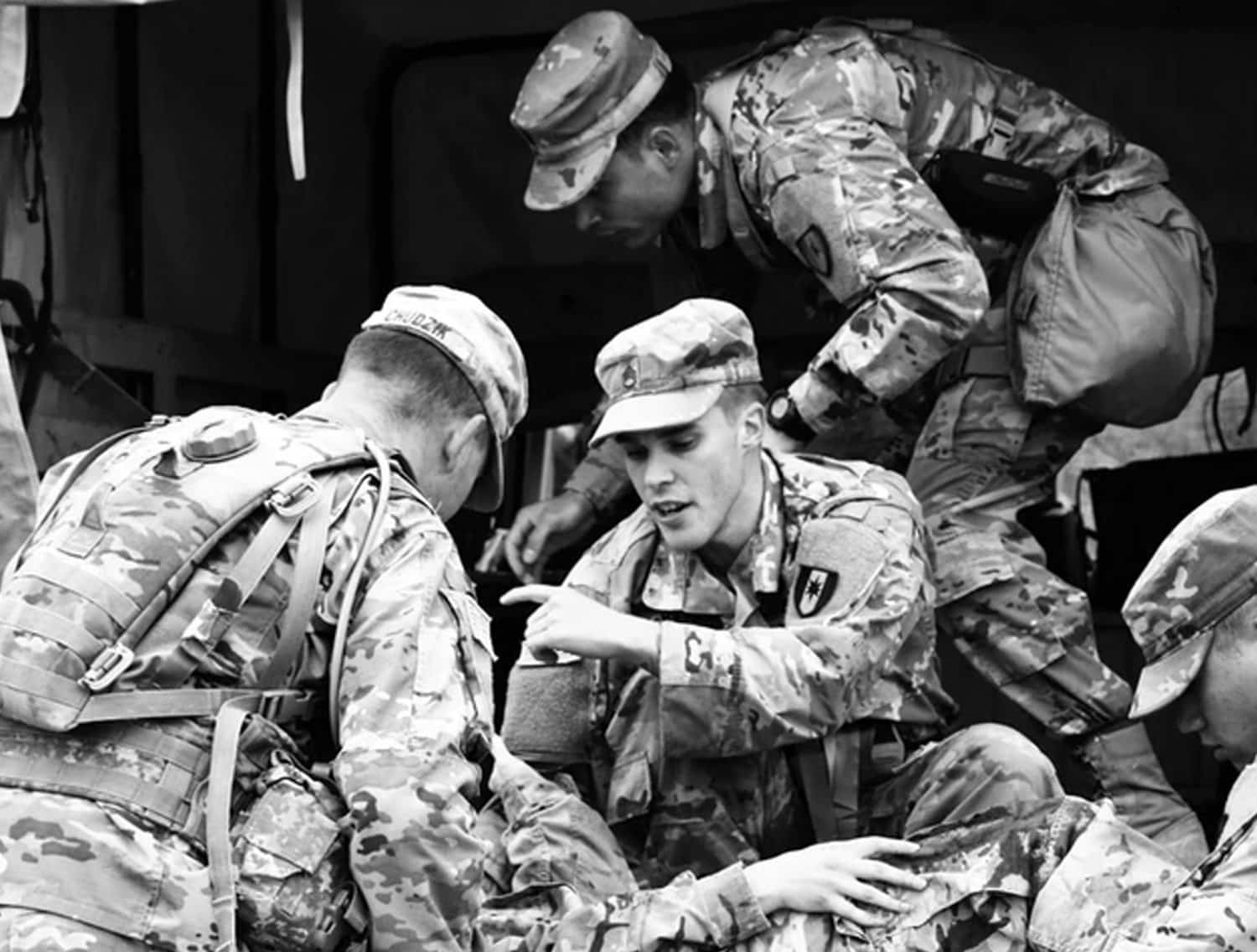The transcription of the webinar “Addressing Trauma With Veterans and Military Personnel”
This is Dr. Courbasson, I’m going to be your host today and we are going to talk about this subject: Addressing
Trauma with Veterans & Military.
Let’s talk a little bit about us. We are an addiction treatment center and we offer virtual, residential and
outpatient addiction rehabilitation treatment for people with concurring addiction and mental health problems. So
we have a diversity of staff who are very eager about helping people with a variety of difficulties. About me, I’m
a registered psychologist with the College of Ontario.
I’ve been working in the field for several years and I enjoy working with people in the military and their family
and other First Responders. I’m also involved in training clinicians in the assessment and treatment of mental
health and addiction problems. Today we’re going to talk a little bit about what we’ve learned from the military
experience, the impact of deployment, the trauma and some features of post-traumatic stress disorders. We will
talk about treatment recommendations, what will work best and also a bit of the recovery program.
What do we know from the military experience?
People are taught to engage in self-care, to be an optimist. We
teach them to read, to educate themselves, listen to understand and learn and think.
To focus on the result to be committed and to follow through. There is mentorship and we ask them to trust their
advisors. And we also help them find other options following the military years. So in terms of the planning,
people are taught to pay attention to what occupation they can do, the income, where they are going to live, and
the lifestyle they will get.
The impact of deployment is huge.
It’s one of the most significant experiences of being in the military. And it affects the quality of the couples’
relationship, the parental relationship and relationships with other family members and friends.
There are also quite a bit of psychological behaviours and physical health changes in the family members. Due to
deployment, the children are also affected. So, we see some emotional, behavioural, social and economic challenges
not only while the person is deployed, but also after the deployment. And there is the military integration. There
is an impact on attitude towards military service and retention.
In terms of the marital relationship, we know that couples are less satisfied with their marriages and there is
less psychological and physical aggression. Prior to deployment, if there is more frequent communication with the
service member during the deployment, and we know that the more communication there is, the greater the marital
satisfaction after the deployment. The exposure to trauma during the deployment, whether it is physical or
psychological, is linked to the spouses with both a higher level of psychological and physical aggression after the deployment. So the spouses will need support also after the deployment.
Exposure to combat during the deployment has been linked to a lower level of psychological aggression from both
the service member and a spouse after the deployment and this is reported by the spouse.
In terms of the impact on the spouses, the separation from the military during post-deployment will affect the
communication with the service member after the deployment. In general, we find lower marital satisfaction.
In terms of the family relationship, there is less day to day challenges associated with family life, for the
service member during and after deployment. There are no significant changes in a family environment across the
deployment for the spouse. And the higher parenting satisfaction during the deployment for the service member.
What we find is there is a lower parenting satisfaction over the entire deployment cycle for the spouse, the
spouse is often left caring for the children in the household. There is a decreased financial distress during
deployment for the service member and spouse. The service member is busy. And the spouse has accepted the
challenges during the deployment. Pre-deployments’ preparation activity is linked to higher satisfaction with
parenting for the service member and spouse.
The armed forces are doing a great job to prepare the family with
that. And there is a negative psychological consequence of deployment that is associated with an increased risk of
family outcome post-deployment for both the service members and the spouse.
The deployment trauma has been linked to increased depression, PTSD, anxiety compared to the pre-deployment
level. The physical injury during the deployment is associated with the spouse’s persistent increasing symptom,
and that includes binge drinking.
The psychological symptoms are varied across the deployment cycle. During deployment, there is a heightened
depressive symptom and less binge drinking for the service member. And people often commented that it could be due
to limited access.
There is an elevated depression, PTSD and anxiety for the spouse as well. And post-deployment separation or
retirement from the military are linked to an increased level of psychological symptoms.
For
children and teens, the changes that have been observed tend to be due to the natural changes rather than
those changes due to deployment. So we see more emotional problems and depression during deployment.
There is quite a little substance use before and during the deployment. But after, there is higher substance use,
there is a higher quality relationship of teens with parents who are deployed.
There’s a higher need for child mental health services compared to spouses.
So when the service member comes back from deployment, we need to be ready to provide support to the service
member, to the spouses and the children. The longer the deployment, the worse. The lengthy separation is linked to
a greater emotional problem and depressive symptoms in children. They grow up not seeing their parent. The combat
trauma is related to poor functioning and relationship. And the psychological trauma is related to better
functioning in relationships for the children.
When children are socialized with other military children during deployment, we find that there is a more
positive outcome.
In terms of military integration, communication with other families during deployment, helps with retention. It
also helps with the spouses and the team commitment during post-deployment. Trauma during deployment, we know, is
linked to decreased military satisfaction among the service member, after the deployment as a decreased retention.
So let’s talk about trauma.
There are different types of trauma. Usually the experience of shocking, it can be overwhelming. There may be a
threat to one’s life, one’s body, emotional safety, psychological safety and well-being.
It’s typically sudden and unexpected. It can happen as a one time or current or it may reoccur.
And whether it reoccurs or whether it’s the one time, it could be short term.
Now, when the trauma occurs again and again, it could happen for a short period. It could be intermittent, it
could be regular or prolonged and continuous and chronic. There are different types of trauma to length and the
situations are different. So we need to be able to provide individuals support based on the characteristic of the
trauma and the individual.
The person may experience trauma directly. The person may witness it or people are traumatized by learning events
that happened to family members or someone close to them.
People can be traumatized by repeated or extreme
exposure to those that are pretty aversive detail of the events. We see that with First Responders and emergency
personnel. And then there are those memories that keep coming back. People have difficulty concentrating. They may
be hyper-alert. They may have heightened physiological activation or reactivity.
Those can be normal. But they may persist and when they proceed, they can become clinical symptoms. We see
emotional dysregulation, so people are very reactive to memories, flashbacks. They have this startle response.
Traumatized people are very careful and they often feel that trauma is happening again. And they may regrow
emotionally and they may shut down. They may dissociate. Sometimes there is a change of back and forth between the
heightened reactivity and the emotional sensual.
These people have difficulty making meaning of things, they interpret things based on the traumatic event. They
may have changes in cognition and believe about themselves and other people.
They often feel alienated from others. They may mistrust people and they may question their belief in God or
morals. We find that many people have difficulty functioning at work or school.
And you can also see the reverse. Some people have been traumatized and they work really hard and they devote
themselves to work so they don’t think about the trauma.
People who have been traumatized earlier, have lower educational and economic attainment. They also tend to lose
their jobs frequently and become unemployed. So we need to help them manage the symptoms so they can gain
employment.
In terms of other features, we see a lot of anger directed at various sources. They may have problems with
authority figures and trouble with the law. They misinterpret cues and they may react to the situation. We see a
lot of substance abuse and anxiety and major depressive disorder in these cases.
They also have health and medical problems and social problems. Also, people who’ve been traumatized tend to have
an early death risk than others.
So the American Psychological Association has recommended varieties of interventions to help people with this
traumatic event.
There is Cognitive Behavioural Therapy, Cognitive Processing Therapy, Cognitive Therapy. We’ve seen Prolonged Exposure
Therapy. Some brief Elective Psychotherapy. So they take strategies from different schools of therapy.
Eye Movement
Desensitization and Reprocessing Therapy (EMDR)
EMDR has become much more popular and it tends to be quicker and effective for a variety of participants.
The American Psychological or Psychiatric Association has found that relaxation is not sufficient. And for the
seeking safety, which was originally used quite a bit for people recovering from military experience, there is not
enough evidence that this treatment works well.
In terms of medication.
Medication can be helpful. There is some conditional recommendation with Fluoxetine, Paroxetine, Sertaline,
Venlafaxine. There is not enough evidence to support the use of Risperidone and Topiramate for these difficulties.
So, psychological intervention is very important. The medication alone is not going to be enough. We
need to help the veterans manage their difficulties and hopefully be able to feel better about their lives and
contribute to society.
In terms of recovery, it’s important to orient people to PTSD. What is PTSD so they can recognize the signs?
We teach them coping skills to help manage their symptoms and also to gain control over those impulses to fight
or flee. This is something that we see a lot. We want to engage them in more of an approach oriented lifestyle
instead of avoiding. We will focus on reducing the PTSD symptoms and their severity but these symptoms may not
always disappear altogether. But we can definitely improve the lives of people with PTSD, and the psychosocial
adjustments.
So why do we orient them to PTSD?
We provide people with statistics so they know that they are not alone. And we also cover the common reaction to
trauma. So they know that their reaction is not so uncommon. We cover the cause and physiology of the PTSD.
We help them identify the triggers of safety and avoidance behaviour. So they can learn to manage these. We also
teach them breathing retraining and this is really important.
An important message we give them is that we will focus on treatment and how PTSD affects them today.
We help them see that the past cannot change, and we can help them manage their life in the present and be better
equipped for the future. And we engage them in a daily exercise that they can practice. So they learn to practice
the skill that becomes more routine and they can better manage stressful situations.
When we cover the common reaction to trauma, we definitely cover the fear and anxiety. Re-experiencing the trauma
is common, this increased arousal, avoiding these anger problems mean irritability, being easily annoyed. It’s
very common to see the guilt and shame, depression and grief. We also recognize that their relationships are
affected and many people will engage in alcohol and other drugs to manage their symptoms.
In terms of recognizing the triggers, we want to make sure that we use the different senses and different factors
that involve in this trigger.
So we pay attention to different sights, the smells, the places, the sounds, the physical reaction and activities
and situations that are linked to the triggers. They may have a few of them or they have all of them. What’s
important is we can help them recognize these triggers and by being better equipped, they don’t fight or redraw
when they have this trigger.
Focusing on avoidance and safety behaviours are critical. We hear many times that people are staying away from
malls, from movie theatres, sports arenas, restaurants and any places that tend to be crowded.
Many people may not want to ride in the passenger’s seat. They want to be the one driving. People may avoid
shopping late at night. Or they may shop late, so they don’t see other people. Many people don’t answer their
phone and they stay in their room.
In terms of safety behaviour, we see a lot of them tend to be sitting with a wall at their back. They keep
scanning for threats. Some of them carry a weapon. And they may be checking locks, doors and windows just to make
sure they’re safe.
Some people also engage in patrolling the area around their home. They need to convince themselves that they are
safe.
To keep them grounded and to help them focus on different aspects of the situation, we teach them the slow
breathing exercises.
It’s a very basic exercise. They take a normal breath in through their nose while keeping the mouth closed. And
they exhale slowly through the mouth. While they exhale, they can silently say to themselves the word “calm” or
“relax” very slowly. And we engage them to repeat this for about 10 minutes. Then we assess their tension before
and after this exercise.
And the participants tell us that they do experience less tension after engaging in this. So during sessions when
they become dysregulated, we may use that exercise.
And we ask them to practice this several times a day when they are out of sessions.
We also will engage in Exposure Therapy. They have the perception that things may be dangerous. Things
may indeed feel dangerous because of the past traumatic experiences that they had. But these things may not be
dangerous themselves. They just feel dangerous.
So we will start with a very low anxiety-producing situation. We’ll get them to practice their deep breathing and
practice telling themselves that just because it feels venturous, it doesn’t mean it just really is.
They will stay in the exposure. And often they feel that the distress is down. And they will practice this on a
daily basis.
The exposure can be quite useful. We do a hierarchy of anxiety-provoking situations and we will start with the
lowest provoking situation and gradually we will move up the ladder. We tend to stay at the same level until there
is at least a half of the intensity of anxiety that is reduced. It’s slow, but we know that people can gradually
become more at ease with this situation.
We use a subjective unit of distress so they will tell us how distressed they feel from zero (no distress) to 100
(maximum distress). And we often give them an anchor. You know, zero would be watching their favourite TV show.
And one would be, for example, someone who has an issue with a crowded mall. That would be the most.
And they will rate their distress. And we will focus on the same situation until they feel the distress is
reduced by at least half.
So the personal hierarchy of Triggers, Safety Behaviours and Avoidance Behaviors are created.
And we will give them homework. We’ll make them practice Exposure Practice Sheets that tell us when they start
the day, the time, how long they do it for, what is the level of the stress at the beginning, during the time, and
at the time they finished and how they feel after. We want them to be able to see that if staying in the same
situation is that stressful, or if the intensity of the distress is reduced.
We will also engage them in a Drop Tree Relaxation Exercise:
1) So the first step is to drop your jaw. So we will instruct you to make sure your tongue falls to the bottom of
your mouth. If your mouth is open a little, you’re doing it right.
2) Drop your shoulder. Let them loosen and fall.
3) And drop your stomach. Don’t hold it tight, just let it go.
We instruct them to notice any sensation and any change that they may experience. And this exercise can be done
at any time and anywhere. So for example, if they are waiting for the bus, they can do that exercise.
It will help them cope with being around people. And they can become more relaxed.
We will ask them to practice at least five times a day. We want them to practice outside of the anxiety-producing
situation. So that when they encounter an anxiety-producing situation, they are able to use these strategies.
But if they don’t practice and when they have an anxiety-producing situation, they won’t be able to call on their
skill.
Self-talk is very important. We want them to use self-calming and reassuring statements. For example:
- I’m a good person going through a rough time.
- This might be annoying, but it’s not dangerous.
- I can handle it and I will get better.
So each person has their own favourites. We want them to have a couple of these handy to keep repeating to
themselves.
To help veterans and military personnel with trauma, we also focus on grounding. They have to focus on the
present using their different senses. We teach them to find a safe place. Whether it is a real safe place or
sometimes it’s only imaginary. We will often have an imagery exercise that is the place that they can go to in
their head that calms them. A place that is safe.
We raise their awareness of emotional numbing. In the past, there may have been instructed to leave their
emotions aside. They had tasks to accomplish. The problem is, after putting their emotions aside, they often lose
the ability to know how they feel. To name the emotion of the experience, they are afraid that if they experience
the emotion, it will become out of control. But emotions and feelings matter in civilian life. They need to be
able to communicate and express themselves. So we focus on it, the recognition and the expression of emotions. We
also work on their best self-statement. Who is the person that they want to be? And we can help them select the
attributes they have control over. And we help them establish a road map.
Many people with PTSD will abuse alcohol and other drugs. It’s important to help them see why they experience it
and why they use those substances. So we want to know how they use and why. What’s helpful and not helpful in
using them? They often have a lot of negative impacts after using substances. And yet they continue to use that.
Because there is a part of them that they find helpful. So we need to help them find other ways to get the help
they need, other than with substances. We also help them identify the consequences of substance use on themselves
and other people.
Not only the present consequences but those for their futures. And we help them find alternatives to substance
use.
We will work with helping them recognize their anger. What anger looks like. What is the change in their bodies,
where do they become tense? Do they change the breathing? Do the shoulders change? And then we teach them skills
to manage anger, breathing with grounding statements exercise.
We also teach them assertiveness strategies. Many times they have been told not to communicate how they feel,
they are used to follow orders. I have someone recently who was having a lot of distress and was brought to the
emergency. An emergency staff says, “Well, what would you like to do to help yourself?” And he says, “I’m a
soldier. I receive orders. I don’t tell what I’m supposed to do.” So we want them to make sure that they
communicate and realize what they need. And we also focus on cooling down behaviours or physical activity, talking
to other people, what soothing strategies they can use of the environment, writing. All kinds of different things
to help them cool down their behaviours.
Acceptance is key.
We can’t change the past. But we can help them cope with the present. So we’ll help them let go of fighting
reality. Being in the present moment. And we help them noticing the choices that they have. Instead of focusing on
staying in control and looking at what the options choices are, they need to learn to tolerate the moment.
Acknowledging what is not how things should be, and it can be very difficult, so it’s a process. We focus on
observing rather than judging and dealing with the situation for what it is.
CBT model is very useful. There is a common thinking error that we help people recognize and change to a more
realistic one. We focus a lot on the recovery. The symptoms are there, we help people cope with it, but we don’t
want to over-focus on the symptom. We will help them do the best they can with what they got. We teach signs of
relapse. We will work on the recovery plan. And a big focus is on resiliency. What are the skills they can learn
in practice? So they don’t give up.
Any questions? Feel free to contact us.








